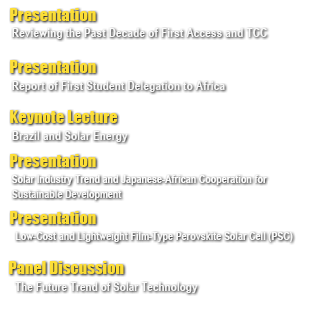
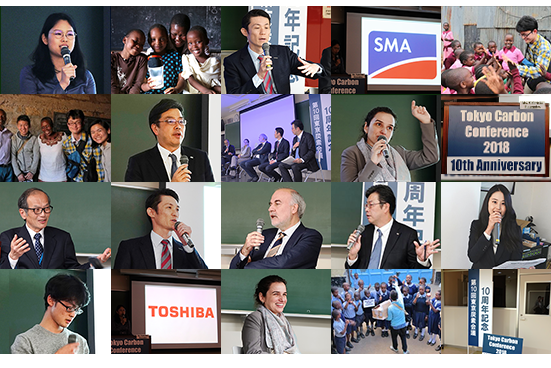
On November 22, 2018, authorized NPO First Access and GREEN HEARTS, a student organization at the University of Tokyo (UTokyo) for international cooperation, held an international symposium g2018 Tokyo Carbon Conference (TCC) - Leading Edge Solar Technologies: Worldfs First Free-Standing String Inverter and Film Based Photovoltaic Moduleh with the support provided by SMA Solar, the leading power conditioner (PCS) maker in Europe. The symposium held in Hongo campus of UTokyo was attended by the representatives of African embassies in Japan, corporate representatives, university students, as well as local news media. It provided a precious interaction opportunity among academia, private and public sector. The following summary was adopted from the lectures and speeches made by our speakers at 2018 TCC.
Presentation
Reviewing the Past Decade of First Access and TCC
Leah Han, Chief Digital Officer (CDO) of First Access
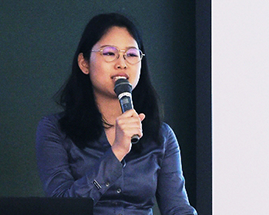
gTo ensure our quality of life in daily lives, to manufacture, and to develop, us living in more developed part of the world rely on the stable supply of electricity. However, 940 million people remain without access to electricity. If you are in a low income household, there is more than 60% chance that you will not have an access to electricity.
Still, access to energy is a basic human need, recognized by the Sustainable Development Goal (SDG) 7, which aims to ensure access to affordable, reliable, sustainable, and modern energy for all by 2030. Recognizing the importance of energy in onefs quality of life, as well as the need for investment in long term development led by young students and their education, First Access was began by three students of the University of Tokyo in 2006. Since then, we have delivered over 1,000 solar lanterns to the children who need them the most.
This year, our Tokyo Carbon Conference marks the 10th anniversary. The topics discussed in the conference ranged from smart community and digital grids to the prospect of geothermal energy in Africa to solar energy. We would like to express a deep gratitude to the participating companies of this event who were willing to share their insights and especially the sponsor companies of our project. It was only possible because there was a shared understanding among our members and the numerous supporters that we should cooperate and proceed towards sustainable and more equitable development.
We hope our solar lamps can brighten the lives of young students, the future of their countries and also the way towards sustainable society for all of us.h
Presentation
Report of First Student Delegation to Africa
Koki Kanagawa, Field Researcher of First Access
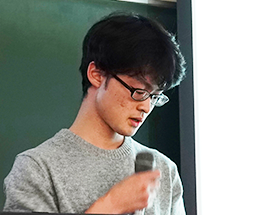
gIn March 2018, First Access dispatched a first student led field research group to Africa. They visited Nairobi, Kenya in order to conduct a energy usage status survey as well as to check on utilization of our solar lanterns donated to marginalized children living in non-electrified regions.
We found out that our partner orphanage in Nairobi which were reported to be located in non-electrified region was in fact connected to the national grid. Yet, they are suffering from frequent disconnection due to the instability in transmission infrastructure, facility failures from heavy rain, and stealing of electricity by village residents.
Under these circumstances, we could confirm that the solar lanterns donated to Patmos Junior School have been immensely helpful for childrenfs education and the daily lives of their neighborhood. Personally, the site visit experience allowed me to reinforce my will to continue and further develop the donation activities of First Access.h
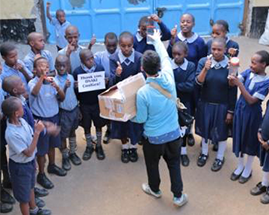
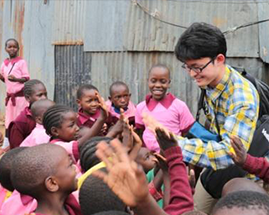
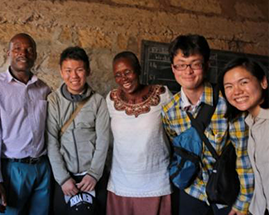
Keynote Lecture
Brazil and Solar Energy
Gabriella Resendes, Counselor of Embassy of Brazil in Japan
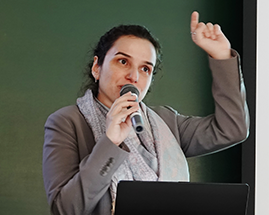
gAs of June 2018, Brazil has an advanced low carbon economy where renewable energy account for 87.8% of the energy produced domestically.
The country is famous for its hydroelectric power and ethanol-fueled vehicles. However, they accelerate Amazon's deforestation and farmland devastation are progressing, and the government has been taking measures to tackle these issues. In this situation, although the ratio for photovoltaic power generation is currently smaller than that of hydropower and ethanol, its market size has rapidly expanded over the past two to three years as equipment prices have fallen over approximately 80%. The market growth recorded 1,000% in the past several years.
Solar power generation is expected to play a larger role in Brazil in the future, but further technological advancement is indispensable. In this regard, technical cooperation with Japan will become increasingly important.h
Presentation
Solar Industry Trend and Japanese-African Cooperation for Sustainable Development
Makoto Ijuin, CEO of PROINSOESolarFor Japan
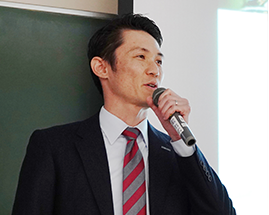
gPROINSO is currently undertaking decentralized electricity generation projects with a total capacity up to 2.7GW in 111 countries around the world. It also offers solar cell mounting racks and post-installment management service. The primary service area is widely classified into three types: 1) business and industry (primarily factory rooftop), 2) residential area and nonelectrified region, 3) electric power company. Within a few decades, we will live in a society where solar power facilities are installed on most existing factory rooftops, instead of cutting down forests to construct new solar power facilities.
Our company received Solar + Power Award in 2016 for the rural electrification project in Riau island, Indonesia, Asia Power Award for a project in Bangladesh this year, as well as Queenfs Awards for Enterprise which is the highest official UK awards given to British businesses and other organizations who excel at international trade, innovation or sustainable development.
As for CSR activities, we partnered with Namene Solar Light Company to bring affordable SM100 solar lights to underprivileged rural and off-grid communities. Implementing partners would pay JPY 1,000 / USD 10 / EUR 10 for solar lanterns whose unit price is JPY 500 / USD 10 / EUR 10 in Japan, America, and Europe, respectively. Thus, one lantern is automatically donated to non-electrified regions per each purchase.h
And then, he moved onto the explanation of various financial supports that can be applied to renewable energy power generation projects between overseas countries and Japanese business. For instance, Japan Bank for International Cooperation (JBIC) has a project finance scheme which provides up to 85% of subsidy for solar power generation projects. He also introduced the Joint Crediting Mechanism (JCM) provided by the government of Japan, which specifically aims for diffusion of leading low carbon technologies from Japan to host countries in order to effectively address climate change mitigation issue.
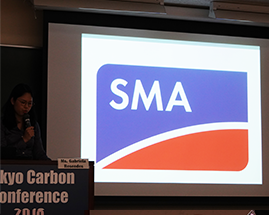
The second half of presentation was delivered on behalf of SMA Solar Technology, the primary sponsor for 2018 Tokyo Carbon Conference. After giving a brief overview of the company and its history, Mr. Ijuin introduced their main product, Power Conditioning System (PCS) which has a broad lineup of commercial (small and large) and residential products. SMA Solar also manufactures optimizer, and the delivery units has reached a total of 65 GW so far.
The topic moved onto the importance of inverter. He described that along with the global technological trend shift towards decentralized power generation, inverters at solar power plants are also becoming increasingly decentralized. Also, he pointed out that the focus of solar power generation itself has evolved from simple gpower generationh to gconsumption of energy createdh. SMA Solar is expected to have comparative advantage in this coming era of smart power generation and consumption environment. He concluded by a remark that: gIf you choose an inverter by only based on low cost, it will fail when dealing with renewable energyh.
During the following Q&A session, a representative from the Embassy of Saudi Arabia asked about the details of financial support provided by the Japanese government. He emphasized, "We would like the transfer of not only equipment but also technology itself to Africa, so that we can be a driver of sustainable development with our own knowledge and resources one day". During the short break after his presentation, many diplomats were forming a long line in front of Mr. Ijuin.
Presentation
Low-Cost and Lightweight Film-Type Perovskite Solar Cell (PSC)
Yutaka Sada, Director of Toshiba Corporate R&D Center
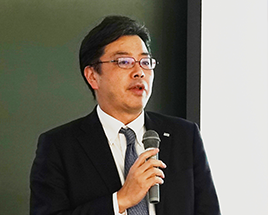
gTorrential rain in western Japan in July 2018 and another predicted torrential rain in India in the following month are not merely a natural disaster, but a man-made disaster from climate change driven by anthropogenic carbon emission. Not only heavy rainfalls, but also various abnormal weather patterns are being observed around the world, and the negative effects of climate change have already begun to affect our lives through reduction in crop production and change of water resources. We must achieve 1.5 C climate goal, it is not an option that we can just choose to try and then give up on the way.
As a corporate citizen of planet Earth, Toshiba Group promotes environmental management, focusing on environmental issues as one of its top management priorities for the future of humanity. The film-type perovskite solar cell developed by Toshiba is not yet commercially available at the moment, but we believe that it will contribute greatly to greenhouse gas emission reduction and hence climate change mitigation and prevention of climate-driven natural disasters once it becomes commercialized in the near future.
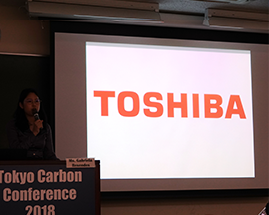
For our new model announced in June earlier this year, the weight was reduced by a factor of 10 compared to the existing ones, and its outstanding flexibility greatly expanded the possibilities of installation sites. Furthermore, it achieved the world's largest area for a single module (24.15cm~29.10cmAArea 703cm2) and energy conversion efficiency of 11.7%. We are now aiming for energy conversion efficiency of 20% and higher. Efficient and affordable film-type perovskite solar cell will allow us to generate electricity with solar power from places that were not considered in the past, such as a roof that cannot withstand the weight of glass windows and solar panels. In terms of transportation and installation, light-weight solar cell grollsh would be much more convenient as well. Contrary to how regular solar panels require professionals for installation, our goal is to create film-type PSC can generate electricity simply by unrolling and placing the film on the desired surface, thereby increasing the accessibility.
Our R&D center is also working on gH2 Oneh project to develop a power storage system using hydrogen energy as a new axis of renewable energy. These researches are conducted in line with the environmental vision of Toshiba Group to realize a low carbon society which strives to coexist with nature.h
Panel Discussion
The Future Trend of Solar Technology
Moderator:
Jun Arima, Professor at Graduate School of Public Policy (GrasPP), The University of Tokyo
Participants:
Gabriella Resendes, Counselor of Embassy of Brazil in Japan
Makoto Ijuin, CEO of PROINSOESolarFor Japan
Yutaka Sada, Director of Toshiba Corporate R&D Center
Enrico Traversa, Science and Technology Officer at Embassy of Italy
This panel discussion was moderated by professor Jun Arima, who specializes in Energy and Environmental Policies at Graduate School of Public Policy, University of Tokyo. First question from professor Arima went to Counselor Resendes, about the possibility of solar power generation in Brazil.

She replied: " The most important factor to lead a societal change is ecost reductionf," and "it may grow to 10% of renewable energy by 2030."
Then, the next question was headed to Mr. Ijuin at PROINSO: gThe price of solar power modules began to fall worldwide from around 2004, and now it is about 70% lower than that time. How do you think envision the price trend of power conditioning system (PCS), a core equipment of the solar power system?h
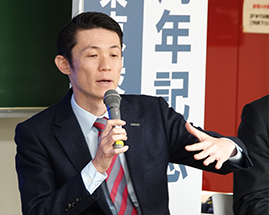
Mr. Ijuin answered:
- ¥ In discussing solar power generation systems, the total price is more important than discussing single items such as PCS, inverters and mounts.
- ¥ It is probably the most expensive in Japan now, but still the installation cost has dropped to less than half compared to six years ago when the Feed-In Tariff (FIT) was launched.
- ¥ However, improving the profitability of relevant business can be realized through not only lowering the initial cost but also increasing the revenue.
- ¥ For instance, the introduction of etrackingf solar power generation device will greatly improve the efficiency and overall profitability, even if it requires initial cost. It means that the profitability of the business will be greatly different even with the gstandsh.
- ¥ Land costs are high especially in Japan, so there are significant benefits to using these latest technologies to improve business profitability.
Regarding the follow-up question by professor Arima on when he believes renewable energy will be competitive without FIT, Mr. Ijuin said:
- ¥ The FIT for photovoltaic power generation has fallen from the initial JPY40/kWh to JPY18/kWh and is expected to be JPY15/kWh next year. As in other countries, the day when grid parity can be realized in Japan is getting closer.
- ¥ Some people in Japanese solar power industry think that gWhen solar energy is over when FIT ends,h but we consider that gThe end of FIT is the true beginning of solar power generationh.
- ¥ However, in Japan, there is a law which prohibits solar power generation equipment installed on the roof of a factory to generate electricity for personal consumption, so we need a discussion on the systemic review on such regulations.
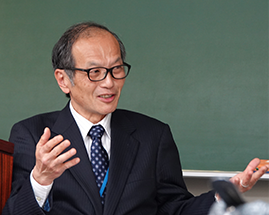
Then, professor Arima asked Mr. Sada, "What kind of policy is desirable from a company like Toshiba who is committed to developing low-carbon power generation technology?"
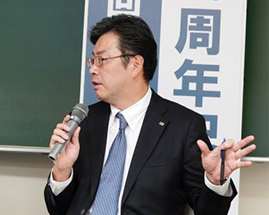
The response from Mr. Sada was:
- ¥ In order to achieve stable supply of electricity, we need to keep energy source diversification using nuclear energy and fossil fuels which can complement renewable energy.
- ¥ Policy backup on electricity storage will be necessary to further increase the use of low carbon energy under such environment
- ¥ From now on, EV batteries and household power storage devices should also be used for system stabilization.
- ¥ Since changes in laws and regulations are essential to achieve it, policy backup to use small distributed power supplies and batteries will be necessary in this regard as well.
Lastly, professor Arima asked Mr. Traversa, "Italy achieved a high solar power generation ratio. What is the role served by Italy in promoting solar power throughout Europe?"

Mr. Traversa replied:
- ¥ As you mentioned, Italy is leading in the utilization of renewable energy, where 39% of nation (20% with hydropower only) is already being powered by renewable energy sources.
- ¥ And in such Italy as well, FIT definitely played an important role in the beginning.
- ¥ On the other hand, system stabilization had paralleled the realization of a high renewable energy ratio. We built a system that can absorb fluctuations from renewable energy usage through maintaining thermal power generation with natural gas. Mr. Traversa concluded his response by citing a case in which Brazil cooperated with Italy in using solar power generation.

MC
Ms. Risako Yamamoto, Director, First Access

